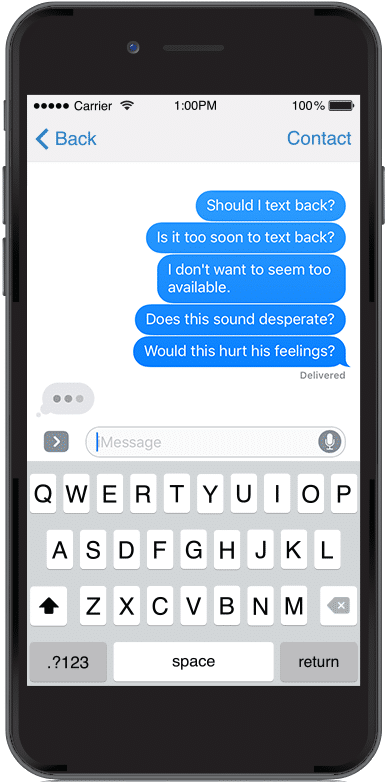
Recommended listening: Quit Playing Games (With My Heart) ? Backstreet Boys
?Don?t leave me hangin? here forever?
The three dots and screenshots. Navigating the rules of texting and dating is one of the less fun aspects of dating in the 21st century.

I can remember the anticipation I felt waiting for texts back from the man I would eventually marry, before the three bouncing dots, read receipts, and sending screenshots to friends were even a thing. Maybe I?d forward a text or two of his to a friend, followed with ?What could this mean???
The experience of texting has morphed into something much more complex than anticipation and a spike in dopamine with each ?good morning? text.
With technology almost inseparable from the process of finding and building a relationship, the dating game is unrecognizable from days past. Unspoken rules dictate the usage of messaging and apps to communicate with potential romantic partners.
And it seems that we don?t really know what the rules are?
In these questions, there is an avoidance of direct expression of one?s interest (or lack thereof) in another person. With the spirit of hookup culture ? play it cool ? guiding texting behavior, no one wants to be the first to express interest, state preferences, or communicate needs.

Doing so requires risk and vulnerability, with the possibility of interest being unrequited. A text back too soon may signify a surrender ? losing the game of emotional chicken characteristic of the early stages of modern texting and dating.
Taking that risk can be scary, especially in a dating environment where it?s not cool to care. There?s discomfort on all sides, whether you are making the first move, waiting for a reply, responding, or directly saying ?no thanks.?
When the other person is not physically present, it?s easier to do nothing rather than face the discomfort of communicating interest, letting someone down, or breaking the rules of the game. So, the bouncing three dots disappear?no reply.
But at what cost? Our shying away from discomfort means shutting out other opportunities that come with it.
Perhaps what is missed is a night out with a person you?d genuinely like to get to know. There?s also the energy lost in deliberating over timing and content to craft the perfect casual text. What used to be the exciting initial phase of getting to know someone has shifted to one of frustration, missed connections, and worry.
Yet, texting and technology don?t have to be a relational stressor and have the potential to enhance relationships when used to communicate how we feel, especially among young adults. How do we get there?
Choose Values Over Avoidance When Texting Back
When you hear yourself asking, ?Should I??? take a step back. ?Should? questions and statements often guide us away from our values and what we want in life, shifting our mindset from what we think to worry about what others think.
Instead, think about what kind of partner you hope to be, and start practicing those values and behaviors now. This could mean stepping out of the game and sending a text when you would like to talk to or see that person of interest.
If someone you like texts you, a text back can communicate trust and care to that person, increasing their positive emotions associated with hearing from you.
If you decide to end a texting relationship with another person, consider that the discomfort of not knowing where he or she stands could be more distressing and energy-draining than knowing you?re no longer interested.
While technology has changed how we meet and interact with potential partners, the science of building connection remains the same.
Outside of hook-up culture and the millennial generation, emotional needs and dependence on another person also get a bad reputation. Yet, according to attachment research, having a secure partnership is empowering to our individuality, known as the dependency paradox.
Security is established when we build trust with our partners, through consistent communication patterns, validation, and emotional availability. Even as we use texting and apps to communicate, we can ask for what we need, state how we feel, and respond to others who do the same.
Texting and Dating Etiquette: Practicing Self-Care
While in the midst of an unavoidable texting dilemma, practice self-care.
- Practice non-judgment: Our brain tends to work on overdrive to relieve uncertainty and ambiguity; while we wait for a text back it will make up all kinds of stories to fill in the gaps. Rather than engage with the struggle of judging the situation to be chill or not chill, simply note the facts of the situation.
- Own your communication needs: The truth is, there is no right or wrong way to text back. Texting should be tailored to match you and your partner?s styles of communication and attachment. It?s okay to say that you?d like something to be different, and collaborate to find a workable solution.
Decoding the rules of texting back is one of the growing pains that come with using technology to connect and communicate with romantic partners.
Where it has been easy to stay comfortable behind our screens, we can choose to use texting as an effective and fun tool for connection and expression.
Originally published at www.psychbytes.com on March 13, 2019.


